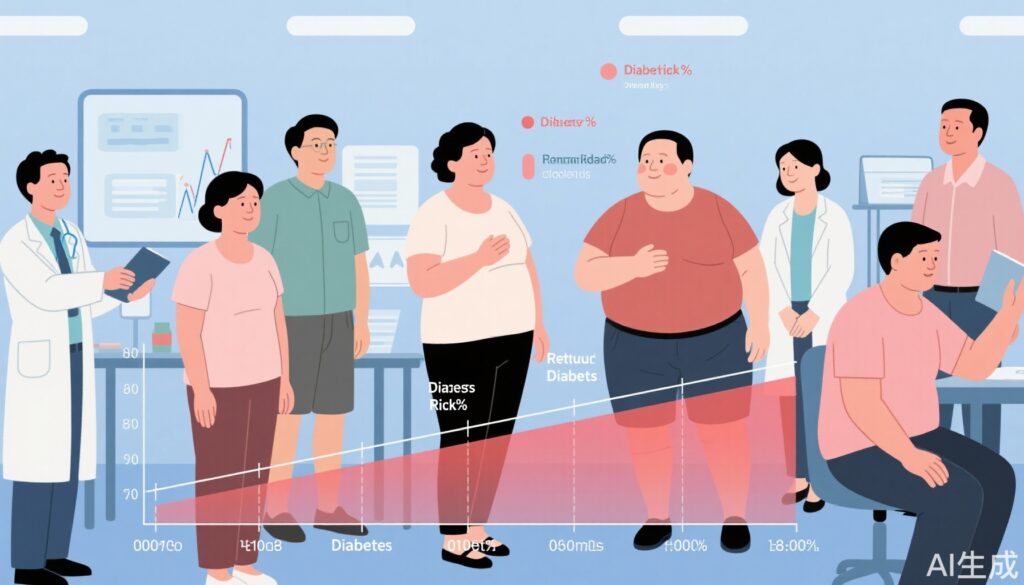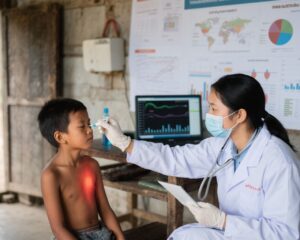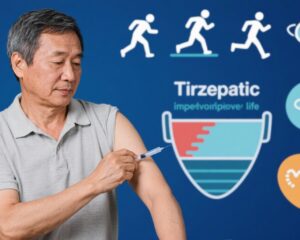Highlight
- Tirzepatide treatment significantly decreased the 10-year predicted risk of type 2 diabetes in Chinese adults with overweight or obesity.
- Risk reductions were evident at both 10 mg and 15 mg doses compared to placebo after 52 weeks.
- Benefit was consistent across subgroups stratified by baseline BMI and prediabetes status.
- Application of the validated QDiabetes-2018 risk model allows for meaningful long-term risk prediction in an Asian population.
Study Background and Disease Burden
Type 2 diabetes (T2D) constitutes a major health challenge globally, with rapidly increasing prevalence in China paralleling the rise in overweight and obesity rates. Obesity is a well-established risk factor for T2D, and effective interventions to reduce diabetes risk in overweight populations are urgently needed to curb morbidity and healthcare burden. Tirzepatide, a novel dual glucose-dependent insulinotropic polypeptide (GIP) and glucagon-like peptide-1 (GLP-1) receptor agonist, has recently emerged as a promising therapeutic agent showing substantial weight reduction and glycemic control benefits. The SURMOUNT-CN trial specifically evaluated tirzepatide in Chinese individuals with obesity or overweight. This post hoc analysis addresses the crucial question of whether tirzepatide not only improves short-term metabolic outcomes but also translates into meaningful reductions in the longer-term predicted risk of T2D development, as estimated by the QDiabetes-2018 risk engine.
The increasing incidence of T2D in China, combined with the high prevalence of overweight and obesity, underscores the importance of targeted therapies that can modify disease trajectory. Predicting the 10-year risk of diabetes enables clinicians to quantify future risk and assess treatment impact beyond conventional measures such as HbA1c or weight loss alone.
Study Design
This post hoc analysis utilized data from the SURMOUNT-CN randomized controlled trial, which enrolled Chinese adults with overweight or obesity. Participants were randomized to receive tirzepatide at doses of 10 mg or 15 mg once weekly, or placebo, over a period of 52 weeks. The sample size was 59, 53, and 57 participants in the tirzepatide 10 mg, 15 mg, and placebo groups respectively. The primary focus here was to examine the 10-year predicted risk of incident T2D, calculated at baseline, week 24, and week 52 using the QDiabetes-2018 risk model—a validated risk prediction tool incorporating demographic, clinical, and laboratory parameters.
A mixed model for repeated measures analyzed changes in mean predicted risk from baseline to weeks 24 and 52 between treatment arms. Subgroup analyses were conducted based on baseline body mass index (BMI) and prediabetes status to evaluate consistency of effect. The QDiabetes-2018 model is well-suited for Asian populations given its derivation from data including diverse ethnic groups.
Key Findings
Baseline demographics and clinical characteristics were similar across the three groups, indicating well-matched cohorts. Initial mean predicted 10-year T2D risks were approximately 5.3% in the tirzepatide 10 mg group, 4.9% in the tirzepatide 15 mg group, and 5.8% in the placebo group.
At 52 weeks, the least squares (LS) mean predicted risk had decreased dramatically in the tirzepatide arms—to 1.2% (10 mg) and 1.0% (15 mg)—compared to a modest decline to 4.5% in the placebo group. The absolute difference in risk reduction compared to placebo was -3.2% (95% CI: -4.2%, -2.2%) for tirzepatide 10 mg, and -3.4% (95% CI: -4.4%, -2.4%) for tirzepatide 15 mg, both statistically significant.
Significantly greater predicted risk reductions were observed across all analyzed subgroups stratified by baseline BMI or prediabetes status, illustrating that tirzepatide’s benefit is robust regardless of baseline metabolic risk severity. The data reflect improvements not only in intermediate metabolic markers but also translate into substantive estimated reductions in long-term T2D risk.
Safety data from the parent trial indicated tirzepatide was generally well tolerated, consistent with its known profile as a GLP-1/GIP receptor agonist, with gastrointestinal adverse effects being the most common but manageable.
Overall, these findings provide compelling evidence that tirzepatide can modify the natural history of obesity-related diabetes risk in a Chinese population.
Expert Commentary
The use of the QDiabetes-2018 risk engine in this cohort is a notable strength, providing an evidence-based and clinically interpretable estimate of long-term diabetes risk rather than relying solely on surrogate endpoints.
Mechanistically, tirzepatide’s dual agonism enhances both incretin pathways, resulting in improved insulin secretion, suppression of glucagon, delayed gastric emptying, and potent weight loss — all pivotal in ameliorating insulin resistance and beta-cell stress.
These data align with global findings from the SURMOUNT program, reinforcing tirzepatide’s role as a disease-modifying agent beyond glycemic control, extending to risk prevention.
Potential limitations include the post hoc nature of this analysis and the relatively short trial duration compared to the 10-year predicted risk horizon. Validation in prospective longitudinal cohort studies examining observed diabetes incidence will be critical.
Furthermore, generalizability to other ethnic populations warrants additional investigation given genetic and environmental differences influencing diabetes pathogenesis.
Conclusion
This post hoc analysis from the SURMOUNT-CN trial demonstrates that tirzepatide significantly reduces the predicted 10-year risk of type 2 diabetes in Chinese adults with overweight or obesity, regardless of baseline BMI and prediabetes status. The results support tirzepatide’s potential as a powerful therapeutic option not only for weight management but also for diabetes prevention in high-risk populations. Future studies with longer follow-up and real-world outcome data are needed to confirm these promising findings and to integrate tirzepatide within clinical diabetes prevention paradigms effectively.
References
1. Zhao L, Tao F, Cheng Z, Lu Y, Liu M, Chen H, et al. Predicting 10-year risk of type 2 diabetes in Chinese people with overweight or obesity treated with Tirzepatide: Post hoc analysis of SURMOUNT-CN trial. Diabetes Obes Metab. 2025;27(8):4118-4125. doi:10.1111/dom.16439.
2. Hippisley-Cox J, Coupland C. Development and validation of QDiabetes-2018 risk prediction algorithm to estimate 10 year risk of developing type 2 diabetes: cohort study. BMJ. 2017;359:j5019.
3. Frias JP, Nauck MA, Van J, et al. Efficacy and safety of tirzepatide monotherapy in patients with type 2 diabetes (SURPASS-1): a double-blind, randomised, Phase 3 trial. Lancet. 2021;398(10301):143-155.
4. American Diabetes Association. 10. Cardiovascular Disease and Risk Management: Standards of Medical Care in Diabetes—2024. Diabetes Care. 2024;47(Suppl 1):S167-S178.



